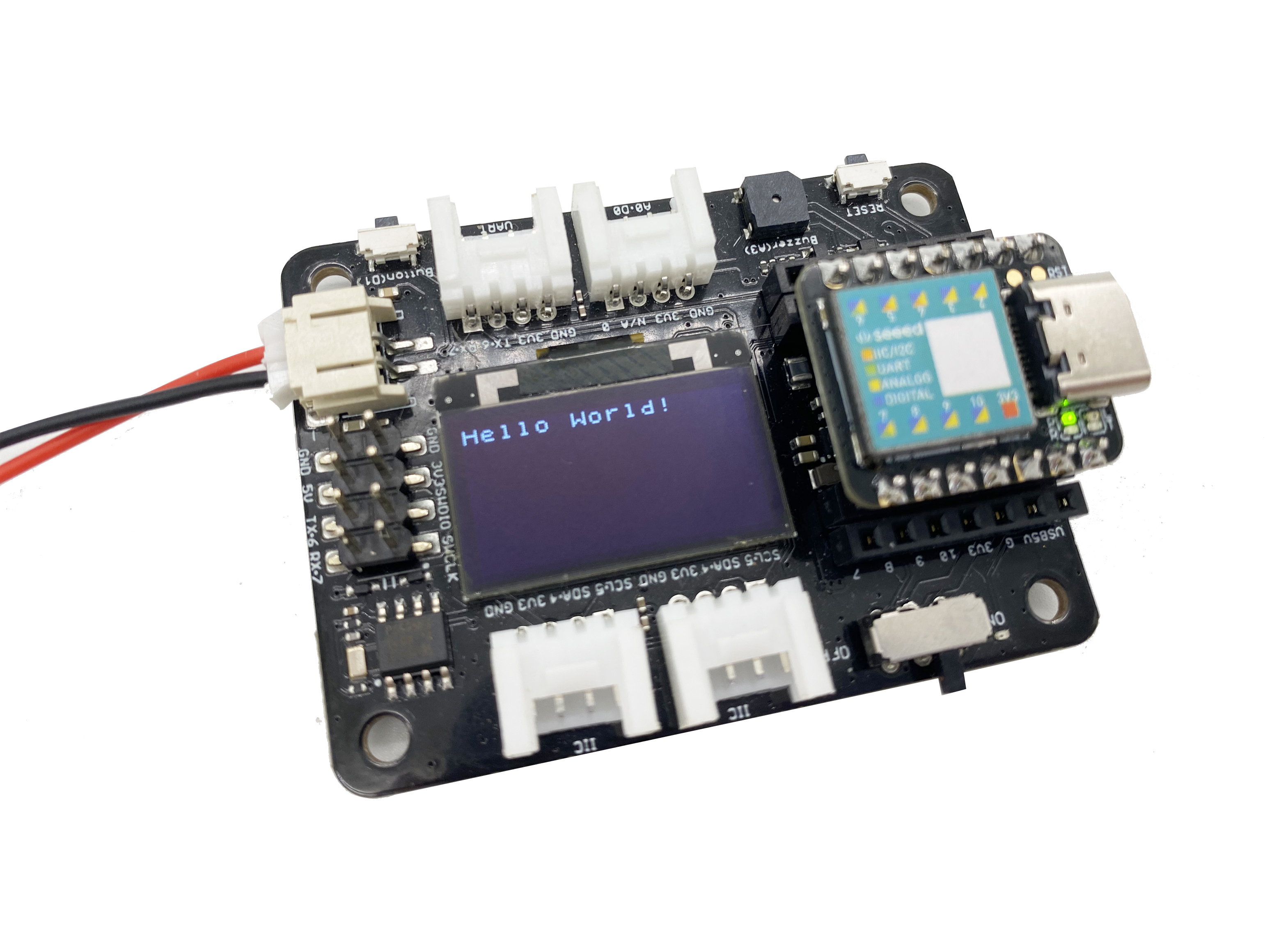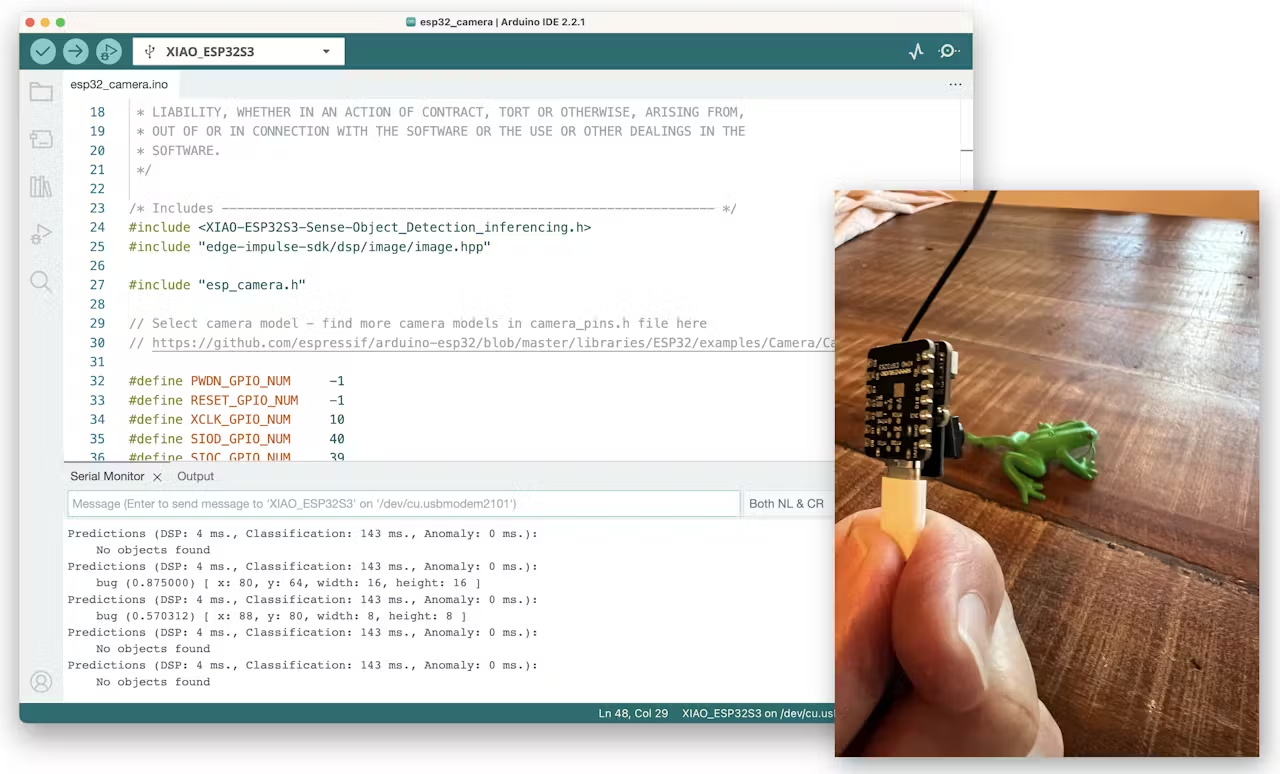XIAO: Big Power, Small Board

AUTHORLei Feng, Marcelo Rovai
PUBLISHEDDecember 8, 2023
Sincere GratitudeJiamou Yang, Yanming Wen, Mengdu Li, Chunchun Tian, Haixu Liu, Tianrui Wang, and Jianjing Huang
Introduction
The Seeed Studio XIAO series represents a groundbreaking evolution in the Arduino ecosystem, merging compactness with powerful performance. Understanding and harnessing its capabilities are essential for any enthusiast or professional in electronics and machine learning. With the rapid progression of technology and the increasing demand for smaller, more efficient devices, mastering XIAO and its integration with TinyML is crucial. It presents a new frontier for innovation, allowing the creation of sophisticated projects in spaces previously thought impossible. This topic is paramount as it aligns with the future trajectory of electronics, IoT, and machine learning, making it indispensable for those aiming to stay at the forefront of technological advancements.
Part List in the Kit

About this Book
Audience
The primary audience for “XIAO: Big Power, Small Board” encompasses hobbyists, students, educators, and professionals in electronics and machine learning who want to explore and maximize the potential of compact hardware platforms. Typically, these readers might hold positions as electronics enthusiasts, DIY project creators, electronics educators, or even junior embedded system developers. As they advance in their careers, they might be eyeing roles such as electronics design engineers, IoT developers, or machine learning hardware integrators.
Our audience possesses a basic understanding of electronics concepts but may have yet to delve deep into Arduino programming or compact hardware design. They likely have encountered standard beginner books on Arduino or general electronics but might have yet to venture into specialized hardware or TinyML. As for skills, they have some hands-on experience with basic electronics or programming but haven’t mastered the intricacies of TinyML or advanced microcontroller functionalities.
What readers will learn
By the end of this book, the reader will understand:
The fundamentals of open-source hardware, focusing on the capabilities of the Seeed Studio XIAO series.
How to transition from basic to advanced electronic projects, starting with simple LED controls and advancing to complex applications like telemetry and voice keyword detection.
The concepts behind prototype design and its practical implications in product development.
The intricacies of integrating various modules like the infrared receiver, ultrasonic distance sensor, and RTC clock with the XIAO platform.
The significance and application of Tiny Machine Learning (TinyML), emphasizing its transformative power in hardware like the XIAO nRF52840 Sense and ESP32S3 Sense.
Techniques to utilize advanced tools such as Edge Impulse Studio for real-world applications like anomaly and object detection and video or sound classification.
The reader will be able to:
Set up, program, and troubleshoot projects across all XIAO series boards, advancing from basic hardware interactions to intricate project designs.
Convert abstract ideas into tangible electronic product prototypes, leveraging the insights from the course.
Design and implement intermediate-level projects such as a Smart Watch and Air Piano using specialized sensors and modules.
Harness the power of Wi-Fi and MQTT protocols with XIAO ESP32C3 for cloud communications and data exchange.
Deploy TinyML on different XIAO boards, executing tasks like image, motion, and sound classification besides anomaly and object detection.
Innovate and extend project ideas, drawing inspiration from a curated collection of XIAO projects and adapting them for custom needs.
Book outline
Chapter 1: Introduction to Hardware and Programming
In this chapter, readers start with basic programming on XIAO using Arduino IDE. Through simple example programs, they will learn to control LED lights, buttons, buzzers, and other electronic components, mastering core programming concepts like digital I/O, analog I/O, tone generation, and mapping values. By manually typing out code examples line-by-line, they will develop strong coding habits and grasp programming syntax.

Chapter 2: Project Practice for Beginners - Introduction to Prototype Design
In this chapter, readers will learn the basics of designing prototypes with XIAO through beginner-friendly projects. They will start from an idea and quickly create a verification prototype, focusing more on the practical application of code rather than line-by-line analysis. By leveraging Arduino libraries, community resources, and example programs, they will learn how to find and adapt code snippets to achieve desired effects efficiently. Furthermore, they will explore how to design the physical appearance of prototypes by creatively combining electronic hardware with everyday items. The key outcomes are grasping a project-based approach and developing skills to build simple interactive prototypes.

Chapter 3: Intermediate Project Practice—Complex Projects
In this chapter, readers will advance their prototyping skills by creating sophisticated IoT projects with XIAO. They will implement features like Wi-Fi connectivity, MQTT telemetry, and remote control commands using the XIAO ESP32C3. Through complex builds like an intelligent remote door, smartwatch, and air piano, you will hone programming techniques for wireless communication, cloud integration, and embedded control. Optional blueprints will be provided, but readers are encouraged to explore creative enclosure designs with alternative materials. The key outcomes are mastering intermediate IoT prototyping and preparing for advanced tinyML applications.

Chapter 4: Project Practice Advanced - tinyML Application
Among the XIAO series products, the Seeed Studio XIAO nRF52840 Sense has Bluetooth 5.0 wireless connectivity, low power consumption, and comes with onboard 6-axis IMU and PDM microphone sensors. The XIAO ESP32S3 Sense further integrates a camera, digital microphone, and SD card support. Those features make them powerful tools for TinyML (Embedded Machine Learning) projects. TinyML solves problems in a completely different way from traditional programming methods. This chapter will introduce readers to this cutting-edge field by walking through the entire machine-learning workflow from data collection, training, and testing to deployment and inference using the Edge Impulse Studio tool.

Chapter 5: Creative Experiments
Since its launch, the Seeed Studio XIAO series has been widely acclaimed for its compact size, powerful performance, and versatile product range. The maker community has produced a large number of projects created with XIAO. Due to space constraints, we have selected some outstanding projects made with XIAO by our makers. These projects fully demonstrate the powerful functions and wide applications of XIAO. Let us follow the makers’ steps, stimulate creativity, and explore the endless possibilities of XIAO. Readers can draw inspiration from these projects, use imagination, and explore new territories with XIAO.

References
Online Courses
- Harvard School of Engineering and Applied Sciences - CS249r: Tiny Machine Learning
- Professional Certificate in Tiny Machine Learning (TinyML) -- edX/Harvard
- Introduction to Embedded Machine Learning - Coursera/Edge Impulse
- Computer Vision with Embedded Machine Learning - Coursera/Edge Impulse
- UNIFEI-IESTI01 TinyML: "Machine Learning for Embedding Devices"
Books
- "Python for Data Analysis by Wes McKinney"
- "Deep Learning with Python" by François Chollet - GitHub Notebooks
- "TinyML" by Pete Warden, Daniel Situnayake
- "TinyML Cookbook" by Gian Marco Iodice
- "Technical Strategy for AI Engineers, In the Era of Deep Learning" by Andrew Ng
- "AI at the Edge" book by Daniel Situnayake, Jenny Plunkett
- "MACHINE LEARNING SYSTEMS for TinyML" Collaborative effort
Projects Repository
About the authors
Lei Feng is the leader of the technical support group and product curriculum at Seeed Studio. An experienced author in the fields of open-source hardware and edge computing, he has published several books in China, including "GameGo Beginner Programming Course for Arcade 《做游戏,玩编程------零基础开发微软 Arcade 掌机游戏》," "Grove Beginner Kit For Arduino - Codecraft Graphical Programming Course 《Arduino 图形化编程轻松学》", and the Chinese translation of "IoT for Beginners 《深入浅出 IoT:完整项目通关实战》" with support from Microsoft China.
Lei Feng has created numerous tutorials and open-source documentation in Chinese and English with his team. His hands-on experience developing IoT and edge computing projects gives him unique insights into simplifying complex concepts for beginners. As an engaging writer and patient teacher, Lei Feng is the ideal guide to make Arduino and TinyML approachable for newcomers worldwide.
LinkedIn profile: https://www.linkedin.com/in/leon-feng-a029bb1/
Marcelo Rovai is a recognized figure in engineering and technology education, holding the title of Professor Honoris Causa from the Federal University of Itajubá, Brazil. His educational background includes an Engineering degree from UNIFEI and an advanced specialization from the Polytechnic School of São Paulo University. Further enhancing his expertise, he earned an MBA from IBMEC (INSPER) and a Master's in Data Science from the Universidad del Desarrollo in Chile.
With a career spanning several high-profile technology companies such as AVIBRAS Airspace, ATT, NCR, and IGT, where he served as Vice President for Latin America, he brings a wealth of industry experience to his academic endeavors. He is a prolific writer on electronics-related topics and shares his knowledge through open platforms like Hackster.io.
In addition to his professional pursuits, he is dedicated to educational outreach, serving as a volunteer professor at UNIFEI and engaging with the TinyML4D group as a Co-Chair, promoting TinyML education in developing countries. His work underscores a commitment to leveraging technology for societal advancement.
LinkedIn profile: https://www.linkedin.com/in/marcelo-jose-rovai-brazil-chile/
Twitter handle: \@mjrovai
Author public speaking samples (YouTube, etc.): https://www.youtube.com/watch?v=KeXlAazzgKw
Tech Support & Product Discussion
Thank you for choosing our products! We are here to provide you with different support to ensure that your experience with our products is as smooth as possible. We offer several communication channels to cater to different preferences and needs.